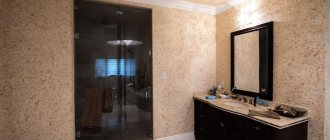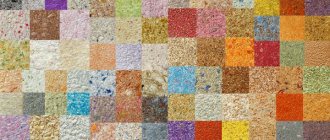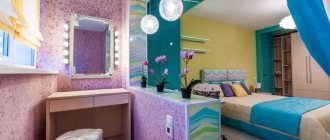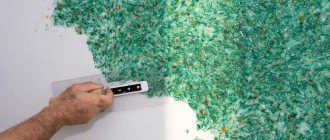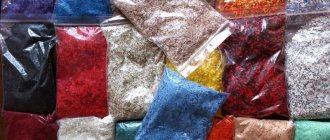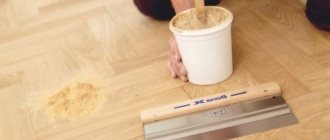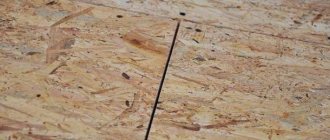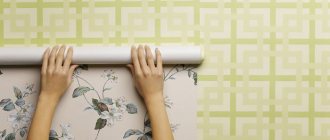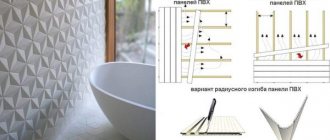If we consider liquid wallpaper as an alternative to modern decorative plasters and all kinds of paints, it should be noted that they are very similar.
However, when applied to a work surface, the structure is different and the result is different. With their help you can create your own interior design. Today, ZhO can be easily purchased at any specialized hardware store. They are sold dry in sealed packaging. The shelf life and application technology are indicated on the back side.
But today we are not interested in the method of applying the finished mixture to the wall, but in caring for the liquid. In particular, the question is about ways to care for them.
What is liquid wallpaper
The composition of dry mixtures includes various raw materials. Such as:
- Cotton.
- Linen.
- Cellulose.
- Glitter.
As well as special adhesive mixtures.
Thanks to natural elements, liquid wallpaper is considered a clean, environmentally friendly raw material. They can be used to decorate walls in any technical and residential premises, or applied to wall surfaces in children's rooms. The material is easy to use. Both professionals and novice builders at the household level can work with the mixtures. If you follow the manufacturer's instructions and follow the sequence of actions, then there will be no problems when applying them.
Is wet cleaning acceptable?
On the one hand, most manufacturers write that it is absolutely impossible to wash such a coating, which is stated in the instructions. On the other hand, this prohibition is not entirely correct, since in some situations and with the proper skill, liquid wallpaper can be washed, although it is undesirable.
First of all, the permissibility of wet cleaning depends on the presence or absence of an acrylic varnish coating. In the first case, cleaning should not cause any particular difficulties, since the varnish will prevent water from entering the structure of the finishing material. In the second case, everything is much worse, since when wet there is a high probability of ruining the finish.
How to care
The issue of caring for liquid wallpaper is not at all idle. The service life of the product depends on the correctness of actions. It is important that due to the antistatic properties of LW (liquid wallpaper), dirt, dust and other debris are practically not attracted to the lined surface.
But, in any case, the finishing needs regular, and most importantly, proper care. If you carefully read the manufacturer's instructions, it will become clear that you CANNOT wash the JO! So how to clean liquid wallpaper from dirt, how to remove small fractions of debris? Manufacturers and experts advise using the dry cleaning method.
In particular, you can effectively care for a lined surface using a household vacuum cleaner. If dirt appears on the wall during use, you can easily remove it using an eraser. You just need to work with it carefully so as not to damage the drawing.
If more serious problems arise than ordinary pollution, the problem area will require partial replacement of the wallpaper. In this case, the technology for applying liquid liquid is similar to the initial treatment of the wall surface.
Heavy soiling
One of the most interesting features of liquid wallpaper is its maintainability. Therefore, an area of the coating where, for example, a child’s drawing with a felt-tip pen needs to be removed, or serious contamination has appeared, can be “restored” by replacing the damaged area with a new one. This method is also applicable if, when trying to wash the coating, the finish was damaged.
To do this, you can use excess “liquid silk”, which usually remains after repair work. To do this, the damaged area is well soaked and carefully removed using a spatula. Then the bare section of the wall is primed to improve adhesion between it and the coating. After this, the finishing material itself is applied.
Note! Before applying liquid wallpaper to the wall, it is better to try applying it to some other surface. This is necessary in order to check how the color will look in the interior. This is especially true if it is not possible to use the same composition that was used during the repair last time.
Those who are just planning to use liquid wallpaper in their apartment or are already carrying out renovation work can be advised not to throw away their remains. As already mentioned, they can be useful for “patches”. It is recommended to store leftovers in securely sealed packaging.
Is it possible to wash
Answering the question: is it possible to wash liquid wallpaper, the answer is yes. But, you need to follow a number of rules, which will be discussed below. To avoid damaging the surface:
- Do not use chemical cleaning agents.
- Do not remove dirt using sandpaper, a wire brush, or other abrasive materials.
- When treating the surface, you do not need to use a large amount of water. In this case, the wallpaper quickly swells, absorbing moisture, and loses its water-repellent properties. In addition, using water in large quantities will inevitably lead to mixing of contaminants with the adhesive composition.
Common mistakes
@dekorshtukaturka.ru
- Use of chemical cleaning agents when washing;
- Removing dirt using abrasive materials (wire brushes, sandpaper);
- If the wallpaper has changed color due to tobacco smoke, when repairing a certain area, you need to choose the shade of the walls that is currently available, and not the one that was originally;
- Sometimes substances that were previously used during finishing can affect the color shade of silk plaster and change it;
- If noticeable yellow spots appear, it means there are metal elements somewhere nearby. In this case, you need to remove the stained areas, apply protective enamel, and then apply the material again.
How to wash liquid wallpaper when cleaning
It's simple: the surface of the wall or a section of wallpaper needs to be wiped with a slightly damp cloth.
Since liquid wallpaper has antistatic properties, frequent treatment is not required.
The issue of servicing liquid metal parts is simpler if they are pre-varnished.
Varnish is known to have water-repellent properties. You can wipe the walls with cleaning products or water. Most often, varnishing at the final stage of applying liquid wallpaper is necessary in rooms with a high degree of humidity. This:
- bathroom;
- toilet;
- kitchen.
The use of varnish in the hallway or living spaces did not justify itself: high costs without a clear effect. In addition, it must be taken into account that after varnishing the silk structure loses the ability to repair individual fragments.
In addition, when renovating premises, it is very difficult to remove liquid coatings coated with varnish; you need to know and remember this.
How to wash properly
- The wallpaper should be varnished. But then silk plaster will lose its main quality - repairability.
- For walls that are not varnished, use a slightly damp, clean cloth.
Attention! Use a lot of water, don't wash it often.
- You can try to erase the greasy stain with an eraser.
- If it doesn’t work, then we take water and a rag. With their help, we soak the dirty area, remove it with a spatula and apply a new layer of wallpaper to this area. The difference with the entire wall will not be visible.
Preparing the premises
To remove liquid wallpaper from the wall, you need to prepare the room. Procedure:
Remove all furniture from the room. If this is not possible, it is covered with plastic wrap.- De-energize the room.
- They remove switches, unscrew sockets, and remove lighting fixtures.
- Remove the baseboards.
- Cover the floor with cardboard and cover it with plastic film on top.
- Windows and doors are covered with cellophane. The most convenient way is to attach it with tape.
If it is not possible to remove all the furniture from the room, it must be moved to the center of the room and covered with film so that there are no cracks or openings.
Preparation of the composition
To prepare the solution, you need to prepare the necessary items. You will need:
- Capacity 7-10 liters, convenient to prepare the mixture in a basin;
- Warm water 25-35 degrees;
- Latex gloves.
How much water is needed to knead a packet of mixture is shown on the packaging. Knead according to the manufacturer's instructions. The general principle of operation is to take some water into a container and pour the contents of the bag into it, mixing the components manually. Gradually add the remaining water until the desired consistency is obtained.
It is recommended to mix by hand, because using a mixer can disrupt the structure of the fibers, and as a result the coating will be damaged.
The mixture is prepared in advance so that it swells well; it should stand in a closed container for 2 to 10 hours.
It is recommended to mix by hand, because using a mixer can disrupt the structure of the fibers.
Varnished wallpaper
The surface protected by a varnish film can be wiped and even washed. If the finish of liquid wallpaper is properly covered with 2-3 layers of acrylic varnish (the best option), then the resulting film can withstand wetting and washing with soft (non-aggressive) agents. When cleaning, the varnish film is protected from damage.
No abrasives or hard brushes! Do not use chemicals for cleaning. By damaging the varnish layer, you can lose this “advantage” - the ability to clean the coating by washing. In addition, the varnish may become dull or stained. You can wipe off borscht stains from varnished silk plaster with a clean damp cloth or napkin.
Composition of liquid wallpaper
In addition to cellulose fibers, liquid wallpaper contains components to achieve various decorative effects. It can be mica or wood chips, algae. Cotton, wool, silk - all only natural ingredients. Wide variety of dyes. Such additives will affect the texture and smell of your future walls. To form the solution - an adhesive substance.
Advice. When choosing liquid wallpaper for the bathroom, pay attention to the labeling. Manufacturers indicate the degree of moisture resistance of this product.
Liquid wallpaper is sold in plastic bags and is a powder. You shouldn't look for them on sale next to regular types of wallpaper. They are most often sold in specialized departments or stores. Or you can try making them yourself.
How to properly wash washable wallpaper
Washable coatings are often smooth, dense with a polymer protective film. This decor can easily withstand wet cleaning. It must be carried out regularly so that dust and dirt do not accumulate on the canvas. We have prepared simple instructions on how to wash washable wallpaper at home.
- We clean the walls from dust. The easiest way is to vacuum them, paying special attention to the corners and joints. If you don’t have a vacuum cleaner, you can use a brush, preferably one with a long handle, or a broom. It is clear that the devices must be clean.
- We carefully inspect the surface. If there are stains, treat them with a suitable product until they disappear completely.
- Prepare a cleaning solution that is suitable for the material being processed. Dip a soft cloth into it and squeeze well. Wipe the base with a damp cloth. You can do this with your hands or, for convenience, wrap the fabric around a broom or brush.
- Rinse off the soap solution with clean water. Wipe the base dry.
What will you need?
You need to take care of the tools in advance , since without them it will not be possible to remove the covering from the walls. If you have a grinding machine in the house, then you can only get by with it. To work at height, use a stepladder.
Standing on a table or other improvised platform is dangerous. A shaky structure may not support the weight of a working person. For personal protection, use goggles, a respirator and gloves.
If there is no sanding machine, wallpaper removal is done manually. To do this, choose from the following substances:
- liquid soap, a bar of laundry soap or dishwashing detergent;
- vinegar 9%;
- store-bought wallpaper removers.
You do not need to purchase all of the listed ingredients. The choice is made in favor of one remedy.
Tools required for manual removal of liquid wallpaper:
- ladder;
- putty knife;
- container with water;
- sponge or roller;
- iron;
- rags;
- garbage bags.
After all the tools and substances have been prepared, you can begin processing the walls.
Advantages of liquid wallpaper
Liquid wallpaper can be used in any room. This new material spread very quickly and gained popularity. The possibilities for its use are quite wide and varied. The most daring design ideas and solutions will make the interior unique and interesting.
Durability is a significant plus of liquid wallpaper. It is unlikely that they will have to be changed due to obsolescence. Also environmentally friendly material. In addition to natural cellulose, they also contain a number of components of natural origin. Fungicides, which work as an antiseptic, will prevent the formation of mold and mildew. The antistatic properties of the material prevent the appearance of dust and various small flying particles. As a result, it is safe for people suffering from allergies.
